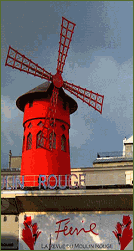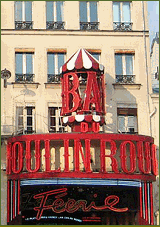|
France and can be instantly recognised by the large red imitation
windmill on its roof of the Moulin Rouge.
Over the past hundred years, the Moulin Rouge has remained a popular tourist destination,
offering musical dance entertainment for adult visitors from around the world and much of
the romance from turn-of-the-century France is still present in the club's decor.
Thanks to its French Cancan, which was immortalised by the painter Toulouse-Lautrec, the
Moulin Rouge has always presented sumptuous shows
to its spectators and even today the concept is still the same, as the Moulin Rouge has
the most beautiful girls in the world.
Many international stars have performed on the stage at the Moulin Rouge and these include
Ella Fitzgerald, Elton John, Frank Sinatra and Liza Minnelli. They have all given
exceptional performances, following in the footsteps of French celebrities such as Maurice
Chevalier and Edith Piaf.
The Moulin Rouge was also the title of a book by Pierre La Mure, which was adapted in 1952
into a film called Moulin Rouge, and starred Jose Ferrer and Zsa-Zsa Gabor. Several
other films have had the same title, including 2001's Moulin Rouge!, which starred Ewan
McGregor and Nicole Kidman and both the 1952 and 2001 films were nominated for the Academy
Award for Best Picture.
Can-Can at the Moulin Rouge
The most poignant feature of an evening at the Moulin Rouge is the nightly cabaret
performance.
The Moulin Rouge is internationally famous as the home of the traditional French Can-Can,
which is still performed there today.
Whilst the dance of the can-can had existed for many years as a respectable, working-class
party dance, it was in the early days of the Moulin Rouge, when courtesans first adapted
the dance to entertain the male clientele.
It was usually performed individually, with the courtesan moving in an increasingly
energetic and provocative way in an attempt to seduce a potential client. It was
very common for them to lift their skirts and reveal their legs, underwear and
occasionally the genitals and as time progressed, the can-cans seen at the Moulin Rouge,
became more and more vulgar and overtly erotic, causing much public outrage.
Later however, with the rising popularity of music hall entertainment in Europe,
courtesans were no longer 'required' at the Moulin Rouge and it became a legitimate
nightclub.
The modern can-can was born as dancers were introduced to entertain the guests, many of
them failed ballet dancers with exceptional skill.
The can-can that we recognise today comes directly from this period and as the vulgarity
of the dance lessened, it became known for its athletic and acrobatic tricks.
Also, by this time the Moulin Rouge had lost much of its former reputation as a high-class
brothel and became a fashionable place for the very best in French society to visit and
see the spectacular cabarets, which have included a traditional French can-can ever since.
The can-can dance is recognisable for the long skirts with heavily frilled undergarments
that the dancers wear, high kicks, splits, cartwheels, hops in a circle whilst holding the
other leg in the air, and other acrobatic tricks, normally accompanied by squeals and
shrieks.
And as the dance became respected, it became less and less crude, but the choreography is
always intended to be a little risque at times and somewhat provocative and a little
naughty.
Today, the Can-Can performed at the Moulin Rouge has iconic status in dance throughout the
World and in France, the Moulin Rouge and the dance that made it famous are regarded with
great respect as part of the French cultural heritage.
|
|



